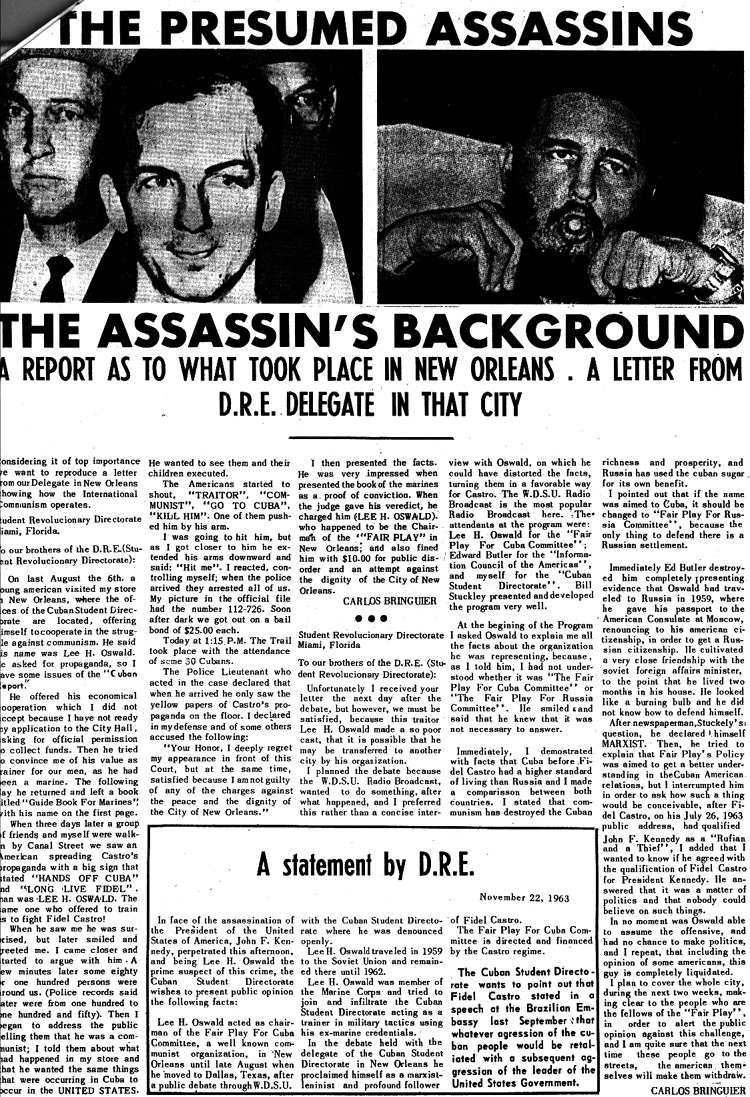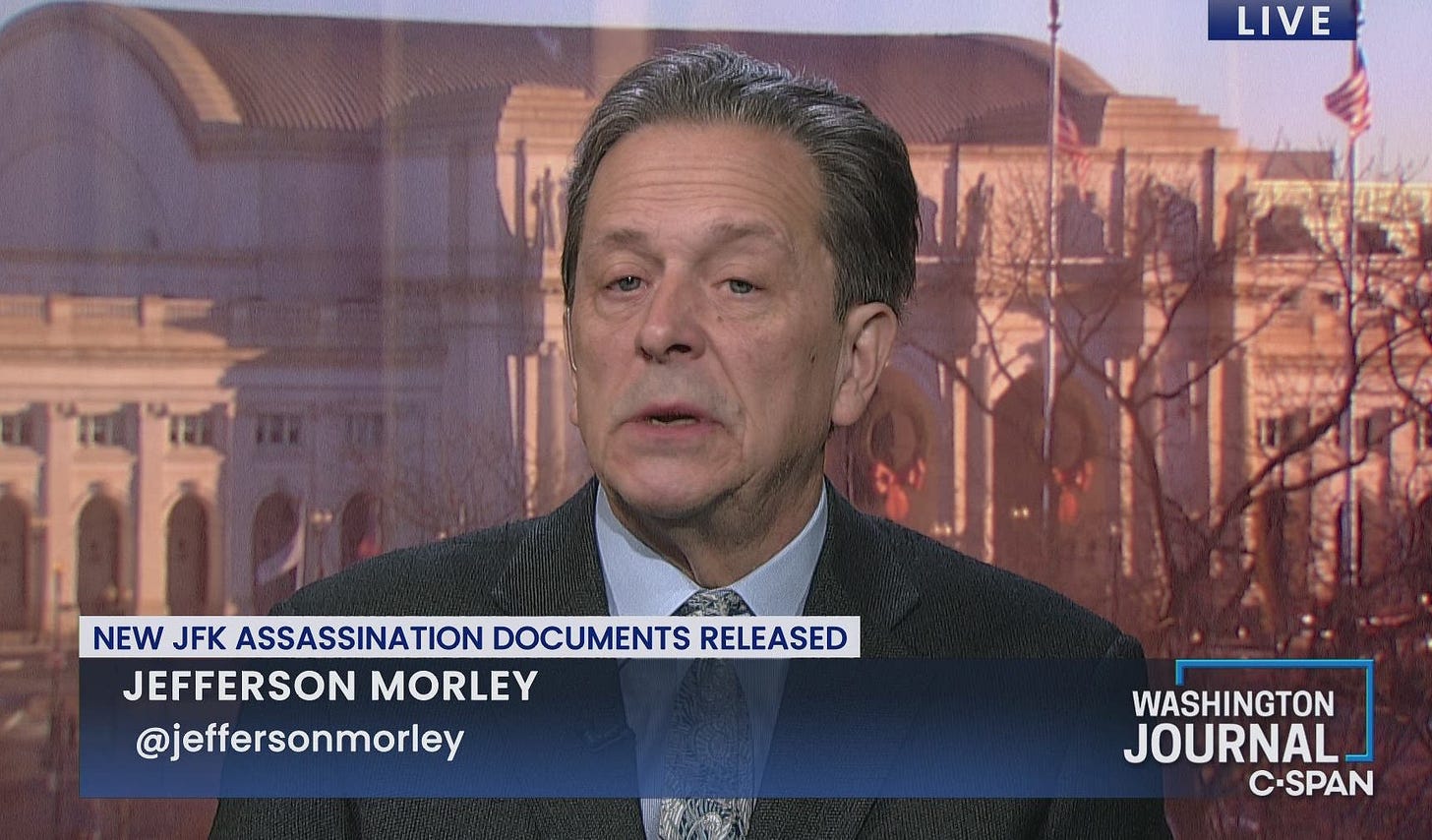
In less than a month, some 16,000 previously withheld or partially redacted records associated with the 1963 assassination of President Kennedy should be released in all their glory to the public. Jeff Morley, former reporter and editor at the Washington Post, has been dogging this story for almost 30 years.
He’s not betting that something explosive will come to light – after all, government agencies like the CIA and FBI have had almost 60 years to dispose of anything embarrassing or incriminating. But he’ll be combing every release for details that might corroborate the myriad scenarios of what took place that fateful day in Dallas’ Dealey Plaza.
But Morley is also still running down leads – like the African-American couple spotted eating lunch on a bench atop the infamous grassy knoll.
“They are the most important JFK witnesses who were never heard from, a couple of kids sitting on the grassy knoll who vanished into history,” Morley writes in his recent article on Substack. “The couple never came forward to recount what they saw. They were never interviewed by investigators. They have never been identified as far as I know.”
The mystery pair were apparently a stone’s throw from where Abraham Zapruder stood filming the presidential motorcade heading down Elm Street. Zapruder’s secretary Marilyn Sitzman mentioned them in a 1966 interview with Josiah Thompson (Six Seconds in Dallas).
“Another thing that I remember this day: there was a colored couple,” Sitzman told Thompson. “I figure they were between 18 and 21, a boy and a girl, sitting on a bench, just almost parallel with me, on my right side, close to the fence.”
In 2010, long-time assassination buff Casey Quinlan identified them as Evelyn King and her brother Arthur. Quinlan’s presentation to a JFK conference was summarized by Joe Backes in a 2012 post on the Education Forum, but it’s unclear whether Quinlan interviewed them or relayed information from yet another source.
Morley wanted to know and he went to Dallas to investigate. “I interviewed a person who claims to have known one of them,” he wrote in 2013. “I could not corroborate those claims.”
He is still looking for any relevant information about the couple on the knoll.
Secrecy bites
The public has long suspected that the assassination of President John F. Kennedy was a conspiracy. Lee Oswald claimed he was a “patsy” – but never revealed for which country. All government files related to the assassination, by law, should have been released to the public by 2017.
They weren’t, which continues to confuse and fuel conspiracy theories.
The CIA and FBI have been holding out – begging both presidents Trump and Biden to give them more time to review their files for “identifiable harm to the military defense, intelligence operations, law enforcement, or the conduct of foreign relations.”
The begging begs the question: Why has it taken almost 60 years for the government to come clean? The Warren Commission concluded Oswald was the lone assassin in 1964. If he acted alone, what secret could be left?”
Tens of thousands of previously classified files have been released to the National Archives since Congress passed the JFK Records Act of 1992, a law inspired by Oliver Stone’s film JFK. Morley is asking if Kennedy’s presumed assassin might have been part of an operation orchestrated by the CIA – to confuse the public about who was really responsible for the deed.
On the Trail of Oswald
When Congress passed the JFK Records Act, it opened what turned out to be a molasses spigot of government disclosure. All assassination records were to be declassified – and any exceptions to the rule had to be submitted to a new agency – the Assassinations Records Review Board (ARRB).
Morley, an assignment editor for the Washington Post’s Sunday Outlook section, was one of the reporters who sat down in the National Archives to wade through newly released files. I have been impressed by Morley’s neutrality and willingness to look under every rock. He still maintains a website dedicated to assassination research, JFKFacts.org.
Among the early releases, Morley found routing slips revealing that senior CIA officials knew the FBI was staking out Oswald in the months prior to Kennedy's murder. More important, Langley withheld information from its own team in Mexico City, where Oswald traveled six weeks before the assassination.
In “The Oswald Files: Tales of the Routing Slips” (April 2, 1995), Morley admitted that the FBI’s monitoring of Oswald was well known – after all, Oswald had defected to the Soviet Union in 1959 and returned with his Russian bride in 1962.
“What is new is that the latest information on Oswald was not passed along to CIA officials in the field,” Morley reported. “The combination of strong CIA interest in Oswald and a desire for internal secrecy suggests the agency may have had some kind of relationship with Oswald that it was trying to protect, according to Edward Lopez, a top Oswald researcher for the 1979 House investigation.”
The House Select Committee on Assassinations concluded (HSCA) in 1979 that Kennedy was “probably assassinated as a result of a conspiracy,” although the committee did not identify the other gunman or the extent of the conspiracy.
Morley was hooked, scouring new document releases and making notes about blacked-out phrases and sections called “redactions.” Eventually he wrote a book, Our Man in Mexico, about Winston Scott, the CIA station chief who monitored Oswald’s movements as he visited the Soviet embassy and Cuban consulate in October, 1963.
A 1996 release of a classified HSCA report by Lopez revealed that FBI Director J. Edgar Hoover and others claimed the man calling himself Oswald in Mexico City was an imposter. The Warren Commission was never told what the FBI and CIA knew about these embassy visits.
Soon, more omissions came to light. In 1998, as the ARRB wrapped up its final report, it ordered the release of the personnel file of a little-known CIA operative named George Joannides. Joannides was remembered by assassination researchers as the guy the CIA called out of retirement to be the official agency liaison to the HSCA some 20 years earlier.
The personnel documents revealed Joannides worked in Miami from late 1962 to 1964, handling and financing the Directorio Revolucionario Estudantil (DRE), or Student Revolutionary Directorate, a group of Cuban exiles that had contact with Oswald in the months before the assassination.
Oswald’s contact with the DRE (think Oliver Stone’s JFK, the quick flashbacks to Oswald in a scuffle handing out pro-Castro leaflets in New Orleans) was one of Morley’s lines of investigation. In 2001, he chastised Richard Helms – CIA chief in 1963 – in a piece for the Miami New Times.
“Helms never told the Warren Commission about his officer's relationship with the exile group,” Morley stated (“Revelation 19.63”). “He never disclosed that the CIA was funding the DRE when it had contact with Oswald, who was agitating on Castro's behalf in New Orleans in August 1963.”
Oswald as False Flag
Morley spent 15 years dogging the Joannides story, filing Freedom of Information Act requests and even suing the CIA. He’s been able to confirm that Cuban DRE students attempted to fly the Castro flag over JFK’s assassination within hours of the Dallas shooting.
“The bulk of the available evidence indicates that Joannides in late 1963 was running a psychological warfare operation [code-named AMSPELL] designed to link Lee Harvey Oswald to the Castro government without disclosing the CIA’s hand,” Morley writes.
Joannides worked at JM/WAVE, a major covert operations and intelligence gathering station at what is today the University of Miami’s South Campus. The CIA’s program to eliminate Castro – Operation Mongoose – was based at JM/WAVE, which grew to be the largest CIA station in the world outside of Langley.
By the evening of Nov. 22, students leaders were telling reporters Oswald was a Castro supporter and part of a Cuban hit team operating out of Mexico City. They published a four-page broadsheet newspaper with the banner headline, “The Presumed Assassins” and photos of Oswald and Castro.

This was probably the very first “conspiratorial explanation” of Kennedy’s death in print, Morley writes after interviewing DRE leaders Juan Salvat and Luis Fernandez-Rocha. The goal of this operation: destabilize the Cuban government and foment public pressure for a U.S. attack.
After almost 60 years, the CIA is still withholding a dozen documents from Joannides’ file on the grounds that their release would still threaten national security.
The agency is also sitting on information about a security clearance Joannides received to participate in a still-undisclosed top-secret operation in the summer of 1963, Morley wrote in the Miami Herald in November.
“If that operation involved AMSPELL agents and Oswald’s Cuba activities, the memo will be strong evidence that certain CIA officers were complicit in Kennedy’s murder,” he writes.
The Last JFK Files
While intelligence agencies have until Dec. 15 to release all assassination records, they might still request further classification.
If Oswald was part of a false flag operation to blame the assassination on Cuban or Soviet hit teams – diverting attention away from a CIA role – it’s unlikely a paper trail still exists anyway.
“I doubt any significant JFK files will be released in the coming weeks or in December, 2022,” Morley writes. “The CIA, of course, could prove me wrong and dispel all doubts by releasing these files in their entirety at any time.”
Conspiracy skeptic Gerald Posner, author of 1993’s well-documented Case Closed, does not expect any document release that will change the embattled history of the assassination.
No revelation will “slow down for one moment those who believe there was a conspiracy behind the death of the president,” he said in a 2021 Lawfare podcast. “The failure to find key documents that make a case different from Oswald alone – and prove the Warren Commission wrong – will not stop people from saying they must have destroyed key material that they’re still looking for.”






